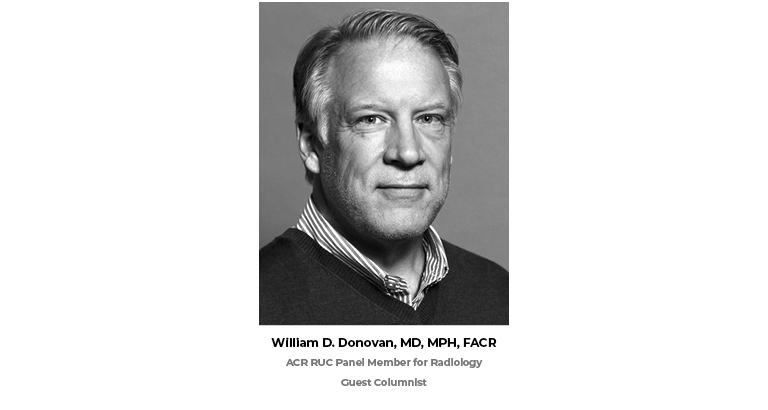In 2007, when my mentor Robert D. Zimmerman, MD, FACR, was president-elect of the American Society of Neuroradiology (ASNR), he asked me if I was interested in serving on an ASNR committee. I answered, “Sure, Bob, of course.” When he asked me if I wanted to help out at the RUC, I answered, “Sure, Bob. What’s the RUC?” My response then remains typical now amongst physicians. Yet the RUC, the AMA/Specialty Society RBRVS Update Committee, has been a crucial force in physician payment for 30 years.1
Medicare began reimbursing physicians according to the Resource-Based Relative Value Scale (RBRVS) in 1991. The AMA organized a method to review the schedule of relative value units (RVUs) for ongoing fairness, and to propose values for new procedures. Hence, the RUC was created. The RUC debates physician work and practice expense for individual CPT® codes and sends its recommendations to CMS. From there, CMS ultimately makes its own RVU determinations in the annual Proposed and Final Rules for the Medicare Physician Fee Schedule (MPFS). In turn, private insurers typically base their schedules on the MPFS. Those decisions, along with Medicare’s annual revision of the Conversion Factor, determine your reimbursement.2
The RUC, which is comprised of representatives from all major medical specialties, went about its business under the radar for its first ten to fifteen years of existence. CMS accepted the RUC’s recommendations nearly universally. That anonymity began to lift in the 2000s.3 The U.S. healthcare budget was continuing a long run of annual increases. Congress, MedPAC, and consumer advocates demanded solutions. Physician reimbursement was brought into the spotlight, along with the disparity in income between primary care practitioners and specialists.
The RUC and CMS set their sights on non-primary care specialties, including radiology. The RUC selected thousands of existing codes for review. Since 2010, nearly every radiology exam and procedure has been scrutinized for “potential misvaluation” by the RUC. Your physician volunteers and the ACR staff have collected, analyzed, and presented survey results and action plans to the RUC Panel for more than 2,000 radiology codes since 2007 — many of them more than once. With this level of engagement from the imaging community, the other RUC Panel members even started calling the group the “Radiology Update Committee.” To say that the ACR volunteers and staff have been successful in defending the value of your work is a profound understatement. Yes, there has been attrition in some areas — the bundling of interventional procedures and advanced imaging practice expense may be the most significant. However, the professional RVUs of the “meat and potatoes” work of diagnostic radiology has been only modestly affected. And now radiology codes are enjoying a relative respite from the target range, since our codes have been so thoroughly checked and re-checked over the past decade.
Currently, our preeminent reimbursement challenge stems from the recent up-valuation of the evaluation and management codes performed chiefly by primary care providers. Their increases mean corresponding decreases in all the other specialties’ payments, by budget-neutral adjustments to the Conversion Factor. The ACR’s legislative affairs group saved the day at the end of 2020 and continues an ongoing fight to mitigate those cuts.4 The CPT and the RUC are also evaluating reimbursement strategies for AI products and arguing for appropriate valuation of work in evolving value-based payment models.5 Stay tuned for future discussions of these issues in this column and at the ACR annual meetings.
The other major news related to the RUC is the appointment of Ezequiel “Zeke” Silva III, MD, FACR, as chair of the RUC Panel. This is huge news for radiology — and a testimony to the high regard in which Zeke is held by the AMA and his fellow RUC Panel members since he began attending the meetings in 2007. He is the first radiologist to be named chair in the RUC’s 30-year history (learn more in the April 2021 Bulletin article at acr.org/RUC-Chair).
The Commission on Economics is grateful to the ACR staff that have been doing the behind-the-scenes work at the RUC. For the past ten years, this has predominantly been the work of Angela Kim, senior director of economics and health policy; Stephanie Le, director of economics and health policy; and Christy Buranaamorn, senior economic policy analyst. They are justly revered by the members of the Commission on Economics — and by their peers from the other specialty societies across the country.
For the full list of ACR members who are radiology representatives to the RUC, visit acr.org/RUC-Reps.

